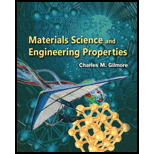
Concept explainers
(a)
The strain where the first change in elastic modulus occurs in composite material.
(a)
Answer to Problem 12.12P
Matrix will rupture before the fiber at the strain of
Explanation of Solution
Given:
Elastic modulus of Boronis
Tensile strength of Boronis
Elastic modulus of Aluminumis
Yield strength of Aluminumis
Ultimate tensile strength of aluminum is
Concept used:
Write the expression for failure strain in Fiber.
Here,
Write the expression for failure strain in Matrix.
Here,
Calculation:
Substitute
Substitute
Conclusion:
Thus, matrix will rupture before the fiber at the strain of
(b)
The composite stress where the change in elastic modulus occurs.
(b)
Answer to Problem 12.12P
The composite stress where the change in elastic modulus occurs is
Explanation of Solution
Given:
Volume percent of Boron fiber is
Volume percent of Aluminumis
Strain at fracture of Aluminumis
Concept used:
Write the expression for stress carried by composite.
Here,
Write the expression for stress in fiber by considering the iso-strain model for axial strain.
Here,
Calculation:
Substitute
Substitute
Conclusion:
Thus, the composite stress where the change in elastic modulus occurs is
(c)
The elastic modulus at low strain and the elastic modulus after Aluminum yields, if Aluminum yields before fiber fails.
(c)
Answer to Problem 12.12P
The elastic modulus at low strain is
Explanation of Solution
Concept used:
Write the expression for modulus of elasticity of composite.
Here,
Calculation:
Substitute
After yielding of matrix the elastic modulus of composite is the elastic modulus of fiber in it. Therefore, the elastic modulus will be equal to 60% of
Conclusion:
Thus, the elastic modulus at low strain is
(d)
Fracture strength of composite.
(d)
Answer to Problem 12.12P
Fracture strength of composite is
Explanation of Solution
Concept used:
Write the expression for fracture strength.
Here,
Calculation:
Substitute
Conclusion:
Thus, the Fracture strength of composite is
Want to see more full solutions like this?
Chapter 12 Solutions
Materials Science And Engineering Properties
- 6. A lake with no outlet is fed by a river with a constant flow of 1200 ft3/s. Water evaporates from the surface at a constant rate of 13 ft3/s per square mile of surface area. The surface area varies with the depth h (in feet) as A (square miles) = 4.5 + 5.5h. What is the equilibrium depth of the lake? Below what river discharge (volume flow rate) will the lake dry up?arrow_forwardProblem 5 (A, B, C and D are fixed). Find the reactions at A and D 8 k B 15 ft A -20 ft C 10 ft Darrow_forwardProblem 4 (A, B, E, D and F are all pin connected and C is fixed) Find the reactions at A, D and F 8 m B 6m E 12 kN D F 4 marrow_forward
- Problem 1 (A, C and D are pins) Find the reactions and A, C and D. D 6 m B 12 kN/m 8 m A C 6 marrow_forwardUniform Grade of Pipe Station of Point A is 9+50.00. Elevation Point A = 250.75.Station of Point B is 13+75.00. Elevation Point B = 244.10 1) Calculate flowline of pipe elevations at every 50 ft. interval (Half Station). 2) Tabulate station and elevation for each station like shown on example 3) Draw Sketcharrow_forward40m 150N B 40marrow_forward
- Note: Please accurately answer it!. I'll give it a thumbs up or down based on the answer quality and precision. Question: What is the group name of Sample B in problem 3 from the image?. By also using the ASTM flow chart!. This unit is soil mechanics btwarrow_forwardPick the rural location of a project site in Victoria, and its catchment area-not bigger than 25 sqkm, and given the below information, determine the rainfall intensity for ARI = 5, 50, 100 year storm event. Show all the details of the procedure. Each student must propose different length of streams and elevations. Use fig below as a sample only. Pt. E-ht. 95.0 200m 600m PLD-M. 91.0 300m Pt. C-93.0 300m PL.B-ht. 92.0 PL.F-ht. 96.0 500m Pt. A-M. 91.00 To be deemed satisfactory the solution must include: Q.F1.1.Choice of catchment location Q.F1.2. A sketch displaying length of stream and elevation Q.F1.3. Catchment's IFD obtained from the Buro of Metheorology for specified ARI Q.F1.4.Calculation of the time of concentration-this must include a detailed determination of the equivalent slope. Q.F1.5.Use must be made of the Bransby-Williams method for the determination of the equivalent slope. Q.F1.6.The graphical display of the estimation of intensities for ARI 5,50, 100 must be shown.arrow_forwardQUANTITY SURVEYINGarrow_forward
 Materials Science And Engineering PropertiesCivil EngineeringISBN:9781111988609Author:Charles GilmorePublisher:Cengage Learning
Materials Science And Engineering PropertiesCivil EngineeringISBN:9781111988609Author:Charles GilmorePublisher:Cengage Learning
